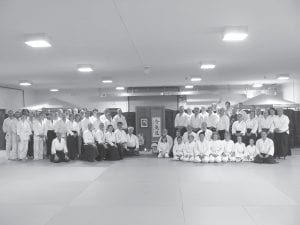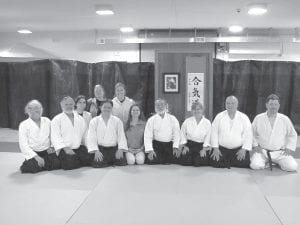More than 60 Aikido students came from near and far to the Grand Marais community center to take part in three days of classes and tests and fun as part of the 20th anniversary celebration of Craig Waver’s Grand Marais Aikikai Dojo. The celebration took place from May 17-20. At night Waver and his family hosted the participants at their Trout Lake Lodge.

Steve Waver was throwing his dad around like a rag doll. Actually, his dad and two other Aikido masters. But his dad, Craig Waver, didn’t seem to mind. He seemed to be enjoying it.
In fact, it was clear that Craig Waver was pleased with the Aikido skills his son was displaying as Steve completed the difficult throws, arm holds, and submission techniques his chief instructor asked of him in this very rigorous test. When it was done, Steve Waver, gasping for breath, was rewarded for his efforts by becoming the first person tested in the county to earn a black belt in Aikido.
While Steve Waver’s test came last, there were quite a few other Aikido students who tested for belts under the watchful eye of the Rev. Zenko Okimura, Shihan, 7th Dan Chief instructor of World Aikido Aikikai, Inc. at the community center on Saturday, May 18.
Locally, Randy Spry and Joanne Smith each earned new belts as they moved up the Aikido ladder. And while Steve Frykman wasn’t tested, he helped a student, acting as a combatant in the rigorous exercise.

Left: Craig Waver (left) and his son, Steve, flank guest instructor Zenko Okimura, Shihan, 7th Dan, Chief Instructor of the World Aikido Aikikai Federation. Zenko judged the students testing for belts on Saturday. His comments were insightful and sometimes very funny. Above: (L-R, front) Members and family friends of the Grand Marais Dojo: Steve Frykman, Craig Waver, Steve Waver, Gederah Waver, Shihan Zenko Okimura, Joanne Smith, Joe Copeland and Randy Spry. (L-R) Westin Waver, Nancy Waver and Cathy Waver.
Held over three days, May 19-21, with suppers and festivities hosted at Waver’s Trout Lake Resort, more than 60 Aikido students came from as far away as Delaware, Colorado, Wisconsin, Michigan and Illinois, to attend the 20th anniversary of Craig Waver’s Grand Marais Aikikai Dojo. It was a celebration held in complete silence during tests.
But once the participants were off the mat and tests were completed, there was much camaraderie. Respect and joy fused with shared love of Aikido was evident amongst participants.
So what is Aikido?
Founded in the early 20th century by Morihei Ueshiba, who as a young man became an expert in jujitsu (unarmed combat), kenjitsu (sword fighting), and sojitsu (spear fighting), Ueshiba wanted to develop Aikido as a combination to show deep respect and compassion for humanity through the martial arts. Called O’Sensei (Great Teacher), Ueshiba said, “Aiki is not a technique to fight with or defeat the enemy. It is the Way to reconcile the world, and make human beings one family.”
Today the Aikido World headquarters Hombu Dojo is located in Tokyo and is run by Morihei’s grandson.
After trying several martial arts, Waver began Aikido training at the University of Northern Illinois in 1975 under the direction of Akira Tohei Shihan, chief instructor of the Midwest Aikido Federation.
When asked why he became interested in martial arts, Waver said, “I was in a bad accident when I was 1½ years old and I was paralyzed on my right side, especially from my knee down to my calf and ankle. As I grew I always heard the saying, ‘How fast do you have to be to get away from a bear? Faster then the other guy.’
“Well, that wasn’t going to work for me. I realized I wasn’t going to be able to run. I would have to turn and face the bear. That’s when I got interested in martial arts.
“I tried a number of martial arts before finding Aikido. When I found Aikido movements could be adjusted for your physical ability, I knew it was right for me. You have to practice with a partner and learn to blend and harmonize on an emotional level, not just a physical level. The philosophy of polishing the mirror and making your inner self come out and shine appealed to me,” said Craig Waver.
In 1985 Waver and his wife moved to Golden, Colorado and he founded the Colorado Aikikai club. He earned his first black belt in 1988, earning the rank of Sensei. In 1992 he moved back to Grand Marais and in 1993 he opened the Grand Marais Aikikai.
Today Waver Sensei holds the rank of Shidoin (4th degree black belt). When he tested for the 4th degree belt, he had to face six Aikido fighters.
“Were they trying to hurt you?” the Cook County News-Herald asked.
“No, but they are trying to knock you down. You definitely have to be prepared and ready,” Waver said.
In July of 1999 Tohei Shihan passed away. “I had a tremendous respect for him,” said Waver, adding, “We were without a Shihan (master instructor) for three years. It was hard because we couldn’t test without a Shihan.”
After attending the 30th anniversary seminar at the University of Minnesota Aikido Club in 2002, Craig met Rev. Zenko Okimura. Okimura agreed to be the Grand Marais Dojo’s Shihan.
As students are tested, they are pitted with fellow students with higher skills. Part of the process, said Waver, is not just learning techniques and throws, but also learning to be thrown. “Students learn to throw, but also must learn to fall,” Waver said.
The overriding goal of Aikido is to learn to avoid confrontations, harmonize with unavoidable ones, and maintain grace under pressure. Besides throws and submission techniques, students are taught to use wooden weapons; the jo (a walking staff); bokken (wooden sword); and tanto (knife).
As an exercise, Aikido improves one’s coordination, balance, stamina, flexibility, coordination and strength, as well as honing one’s mental condition (alertness, confidence and concentration) and learning concern for others.
Waver has seven adults and 10 kids in his Grand Marais Dojo. The older students practice three times a week while the kids practice twice each week. “I make sure the kids realize that they aren’t allowed to use these techniques to show off or hurt someone,” said Waver.
Aikido has three characters. Ai—translates to love or harmony. Ki—is inner energy or spirit and Do—the way or the path. Putting them together, the best western translation would be, “The way of harmony with the spirit of the universe.”
Frykman tried to describe Craig’s role as Sensei, saying, “It is hard to translate in English. A Sensei isn’t just a teacher. A Sensei is one who has come before and is now showing you the way.”
As Frykman spoke, Craig Waver was busy helping a student prepare for a test. His movements were smooth, quick, and patient, belying the fact that he still has some physical limitations. He was calm, confident, showing the student the way…. Indeed, after all of these years, Craig Waver looked like he was ready to face the bear.
For class time and more information, Craig Waver can be reached at (218) 387- 1983.



Loading Comments